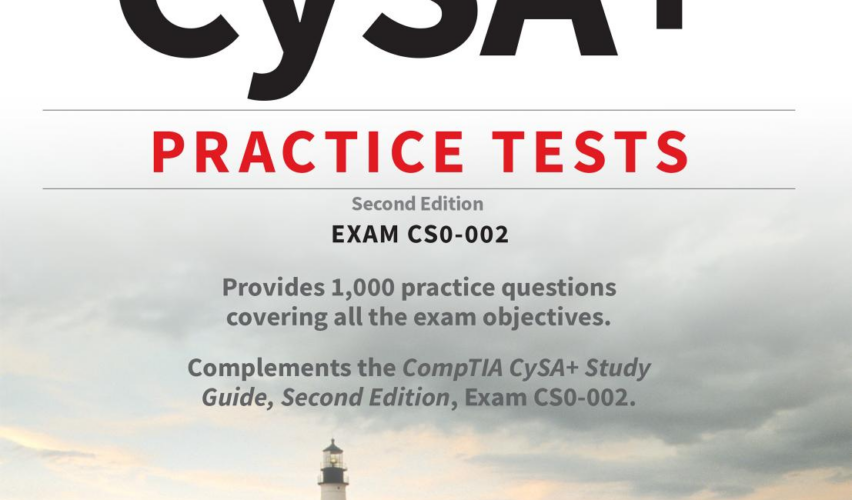Welcome to the ultimate guide on how to successfully navigate and pass the CompTIA Cybersecurity Analyst (CySA+) exam. Whether you’re a seasoned IT professional looking to enhance your skillset or an aspiring cybersecurity specialist, this comprehensive guide will equip you with the knowledge and strategies to excel in the exam.
Understanding the CompTIA CySA+ Exam
The CompTIA CySA+ exam is a pivotal step in validating your cybersecurity expertise. It assesses your ability to analyze threats, detect vulnerabilities, and implement effective solutions. This certification demonstrates your proficiency in real-world cybersecurity scenarios, making you a sought-after professional in the field.
Key Exam Topics
Threat Management
In this section, you’ll delve into the world of threats, understanding their nature, classification, and potential impact. You’ll learn to identify different types of malware, such as viruses, worms, and trojans, and explore strategies to mitigate their risks.
Vulnerability Management
Vulnerabilities are the gateways that attackers exploit. Learn how to conduct vulnerability assessments, prioritize weaknesses, and develop strategies to address them effectively. This includes patch management and the implementation of secure configurations.
Cyber Incident Response
Prepare to handle cybersecurity incidents with efficiency. Understand the stages of incident response, from preparation and identification to containment, eradication, and recovery. You’ll also explore the legal and ethical considerations in incident handling.
Security Architecture and Tool Sets
Explore the architecture of secure systems and networks. Learn to design and implement security solutions that safeguard against various threats. Discover essential security tools, such as firewalls, intrusion detection systems (IDS), and more.
Cybersecurity Toolsets
Dive into the arsenal of cybersecurity tools at your disposal. This section covers tools for monitoring, analysis, and detection. Understand how to select, configure, and effectively use these tools to bolster your organization’s security posture.
Compliance and Governance
Compliance with industry regulations and standards is crucial for maintaining security. Learn about frameworks such as GDPR, HIPAA, and NIST, and explore strategies to align your organization’s practices with these regulations.
Preparing for Success
1. Develop a Study Plan
Creating a well-structured study plan is essential. Break down the exam objectives into manageable sections and allocate time accordingly. Ensure a balance between theory and hands-on practice.
2. Utilize Official Resources
CompTIA offers official study materials, including textbooks, practice exams, and e-learning resources. These materials are tailored to the exam’s content, ensuring a comprehensive and accurate preparation.
3. Hands-on Labs and Simulations
Practice makes perfect. Engage in hands-on labs and simulations that replicate real-world scenarios. This practical experience hones your problem-solving skills and reinforces your understanding of key concepts.
4. Explore Additional Resources
Beyond official resources, explore online tutorials, blogs, and forums dedicated to CySA+ preparation. Engaging with a community of learners can provide valuable insights and tips.
Comparing CySA+ with Other Cybersecurity Certifications
| Certification | Focus | Level | Skills Assessed |
|---|---|---|---|
| CySA+ | Threat analysis | Intermediate | Threat detection, response, and analysis |
| CISSP | Overall security | Advanced | Security management and engineering |
| CEH | Ethical hacking | Intermediate | Penetration testing and vulnerability assessment |
| CompTIA Security+ | Foundational security | Entry-level | Fundamentals of cybersecurity knowledge |
Understanding Exam Format
The CySA+ exam consists of multiple-choice and performance-based questions. The latter assess your practical skills in a simulated environment. Time management is crucial, so allocate sufficient time to each section.
Tips for Exam Day
- Get a good night’s sleep to stay alert during the exam;
- Read questions carefully and manage your time wisely;
- Flag questions you’re unsure about and revisit them later;
- Trust your preparation and stay confident.

What Are the CompTIA CySA+ Exam Details and Cost?
The CompTIA CySA+ assessment, identified by codes CS0-002 and CS0-003, is composed of a maximum of 85 inquiries encompassing both multiple-choice and performance-based formats, and must be completed within 165 minutes. Successful completion of the test requires obtaining a minimum score of 750 on a rating scale spanning from 100 to 900.
- Quantity of Questions: Up to 85 questions at most;
- Question Types: Combination of multiple-choice and performance-based;
- Test Duration: 165 minutes;
- Passing Benchmark: 750 (on a scale from 100 to 900);
- Exam Fee: $392 USD (subject to potential fluctuations by country).
CompTIA provides its own study resources and bundled packages, with a cost range varying between $565 to $977 based on your chosen package.
Numerous examinees manage to pass the examination without investing in the more premium package options. Nonetheless, I strongly recommend considering, at the very least, the fundamental package, which includes the examination voucher, an opportunity for a retake, and a study guide.
Mastering Exam Strategies
1. Time Management
Efficient time management is vital for success in the CySA+ exam. Divide the allotted time among the sections based on their weightage. If you find yourself spending too much time on a single question, move on and return to it later.
2. Read Carefully, Answer Confidently
Read each question carefully to grasp its nuances. Avoid jumping to conclusions or overthinking. After selecting your answer, trust your instincts and avoid second-guessing unless you’re confident in a correction.
3. Prioritize Performance-Based Questions
Performance-based questions require hands-on skills and may consume more time. Allocate adequate time to these questions without compromising other sections.
4. Elimination Strategy
If you’re unsure about an answer, use the process of elimination. Rule out obviously incorrect options to increase your chances of selecting the correct answer.
Charting Your Career Path
Entry-Level CySA+ Roles
After obtaining your CySA+ certification, consider roles such as Security Analyst, SOC (Security Operations Center) Analyst, or Junior Cybersecurity Specialist. These roles provide hands-on experience and a platform for growth.
Advanced Certifications
As you gain experience, consider pursuing advanced certifications like Certified Information Systems Security Professional (CISSP), Certified Ethical Hacker (CEH), or Certified Information Security Manager (CISM) to further elevate your expertise.
Specializations
CySA+ opens the door to various specializations within cybersecurity, such as threat hunting, penetration testing, or incident response. Identify your areas of interest and expertise to shape your career trajectory.
CySA+ Exam Resources: Expert Recommendations
Official Study Guide
The CompTIA CySA+ Study Guide provides comprehensive coverage of exam objectives, practice questions, and real-world scenarios, ensuring you’re fully prepared for the exam.
CySA+ Practice Tests
Utilize practice tests to gauge your readiness and identify areas for improvement. Platforms like Boson and MeasureUp offer realistic practice exams.
Hands-On Labs
Enroll in courses that offer hands-on labs and simulations. These interactive experiences allow you to apply theoretical knowledge to practical scenarios.
Online Communities
Join online forums and communities dedicated to CySA+ preparation. Engaging with peers, sharing experiences, and seeking advice can provide valuable insights.

The Power of Soft Skills in Cybersecurity
Effective Communication
Strong communication skills are vital for conveying complex technical information to non-technical stakeholders. Whether it’s explaining a security incident to management or collaborating with other teams, clear communication ensures alignment and understanding.
Problem-Solving Mindset
The ever-evolving cybersecurity landscape demands quick thinking and innovative problem-solving. Developing the ability to analyze situations from various angles and devise creative solutions is essential for a successful cybersecurity career.
Continuous Learning
Technology evolves rapidly, and so does the threat landscape. A proactive approach to continuous learning is crucial for staying current with new security trends, vulnerabilities, and tools.
Exploring Real-World Tools
Wireshark for Network Analysis
Wireshark is a powerful open-source network protocol analyzer. It allows you to capture and analyze network traffic in real time, providing insights into potential security threats and vulnerabilities.
Snort Intrusion Detection System
Snort is a widely used open-source intrusion detection system (IDS). It detects and alerts on various network activities and potential attacks, enhancing your ability to monitor and respond to threats.
Security Information and Event Management (SIEM)
SIEM tools like Splunk and ELK (Elasticsearch, Logstash, Kibana) collect, analyze, and correlate security-related data from various sources. They provide valuable insights for threat detection and incident response.
The Road to Continuous Improvement
Post-Exam Reflection
Regardless of the exam outcome, reflect on your preparation journey. Identify areas where you excelled and aspects that need improvement. This self-assessment guides your ongoing learning.
Engage in Practical Projects
Apply your CySA+ knowledge to practical projects. Set up a home lab, participate in Capture The Flag (CTF) challenges, or contribute to open-source cybersecurity projects.
Networking and Collaboration
Engage with fellow professionals in the cybersecurity community. Attend conferences, webinars, and workshops to expand your knowledge, exchange insights, and build valuable connections.
Emerging Trends in Cybersecurity
AI-Powered Threat Detection
Artificial Intelligence (AI) and machine learning are revolutionizing threat detection. Advanced algorithms analyze vast amounts of data to identify patterns and anomalies, enhancing the speed and accuracy of cybersecurity operations.
Zero Trust Architecture
Traditional perimeter-based security models are being replaced by zero trust architecture. This approach assumes no inherent trust and requires verification for every user and device accessing a network, minimizing the risk of breaches.
Cloud Security Challenges
As organizations migrate to the cloud, new security challenges arise. Protecting sensitive data, ensuring compliance, and managing access controls in cloud environments demand specialized skills and strategies.

Navigating Ethical Dilemmas in Cybersecurity
Balancing Privacy and Security
Cybersecurity professionals often face the challenge of safeguarding data while respecting user privacy. Striking the right balance requires a thorough understanding of privacy regulations and ethical considerations.
Responsible Disclosure
Discovering vulnerabilities comes with the responsibility to disclose them to affected parties. Ethical hackers play a crucial role in identifying security flaws and collaborating with organizations to address them before exploitation occurs.
The Ethics of Hacking
Ethical hacking, or penetration testing, raises questions about the limits of hacking for the greater good. Professionals in this field must navigate ethical boundaries and ensure their actions align with legal and moral standards.
The Human Element in Cybersecurity
Social Engineering Awareness
While technology plays a vital role in cybersecurity, human error remains a significant vulnerability. Educating employees about social engineering tactics, such as phishing, is essential for preventing data breaches.
Security Training and Culture
Creating a security-conscious culture within an organization is paramount. Regular security training, from the C-suite to entry-level employees, reinforces the importance of cybersecurity practices.
Inclusivity in Cybersecurity
The cybersecurity field benefits from diverse perspectives. Encouraging underrepresented groups to enter the industry helps foster innovation and address the evolving landscape of cyber threats.
Preparing for the Future: Advanced Certifications
Certified Cloud Security Professional (CCSP)
For professionals working with cloud technologies, CCSP validates expertise in cloud security, governance, risk management, and compliance.
Certified Incident Handling Engineer (CIHE)
Building on CySA+ skills, CIHE focuses on advanced incident handling, response strategies, and threat containment techniques.
Certified Information Security Manager (CISM)
Ideal for those aspiring to management roles, CISM emphasizes information risk management, governance, and strategic alignment of cybersecurity with business objectives.
Staying Ahead of Cyber Threats: Threat Intelligence
1. Understanding Threat Intelligence
Threat intelligence involves gathering and analyzing data to identify potential cyber threats. It provides organizations with proactive insights into emerging attack trends, enabling them to take preventive measures.
2. Types of Threat Intelligence
Threat intelligence is classified into strategic, operational, and tactical categories. Strategic intelligence helps with long-term planning, operational intelligence assists in day-to-day decisions, and tactical intelligence aids in immediate response.
3. Sources of Threat Intelligence
Threat intelligence can be derived from open-source intelligence, dark web monitoring, industry-specific reports, and collaboration with cybersecurity communities.
Secure DevOps: Bridging Development and Security
The DevOps Approach
DevOps emphasizes collaboration between development and operations teams to deliver software quickly and efficiently. Integrating security into this process, known as DevSecOps, ensures that security is not an afterthought.
Benefits of DevSecOps
DevSecOps streamlines security measures throughout the development lifecycle. Automated security tests, continuous monitoring, and quick response to vulnerabilities enhance the overall security posture.
Challenges and Solutions
DevSecOps faces challenges like balancing speed and security. Implementing security as code, automating security checks, and fostering a culture of shared responsibility address these challenges.

Cybersecurity Law and Compliance
Legal Frameworks
Numerous cybersecurity laws and regulations govern data protection, privacy, and breach reporting. Familiarize yourself with regulations like GDPR, HIPAA, and the California Consumer Privacy Act (CCPA).
Consequences of Non-Compliance
Non-compliance can result in hefty fines, reputational damage, and legal action. Organizations must adhere to these regulations to ensure the security and privacy of customer data.
Role of Cybersecurity Professionals
Cybersecurity professionals play a crucial role in guiding organizations through compliance requirements, implementing security measures, and ensuring data protection.
Building a Cybersecurity Career Pathway
Entry-Level Roles
Start as a Security Analyst, Junior Penetration Tester, or Network Administrator. These roles provide foundational experience in cybersecurity.
Mid-Level Roles
Progress to positions like SOC Analyst, Security Engineer, or Cloud Security Specialist. Mid-level roles involve more responsibility and specialized skills.
Senior and Leadership Roles
As you accumulate experience and expertise, pursue roles such as Chief Information Security Officer (CISO), Security Consultant, or Threat Intelligence Analyst.
Conclusion
Becoming a certified CompTIA CySA+ professional opens doors to exciting opportunities in the cybersecurity realm. By mastering threat analysis, vulnerability management, and incident response, you’re equipped to defend against evolving cyber threats.
FAQs
While CySA+ is more intermediate, it’s achievable with dedication and thorough preparation. Beginners might benefit from starting with CompTIA Security+.
While there are no strict prerequisites, having foundational knowledge in networking and security concepts is beneficial.
CompTIA periodically updates exam content to reflect the evolving cybersecurity landscape.
Yes, CompTIA offers an online proctored exam option for convenience.
CySA+ certification can lead to roles such as cybersecurity analyst, security engineer, or threat analyst.







